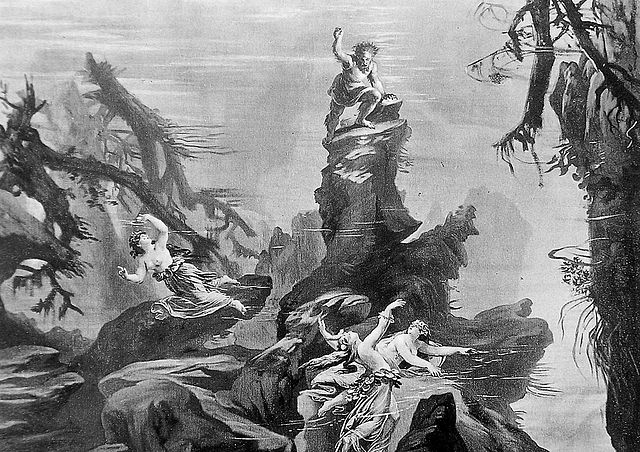Der Ring des Nibelungen, WWV 86, is a cycle of four German-language epic music dramas composed by Richard Wagner. The works are based loosely on characters from Germanic heroic legend, namely Norse legendary sagas and the Nibelungenlied. The composer termed the cycle a "Bühnenfestspiel", structured in three days preceded by a Vorabend. It is often referred to as the Ring cycle, Wagner's Ring, or simply The Ring.
Scene 1 of Das Rheingold from the first Bayreuth Festival production of the Bühnenfestspiel in 1876
Illustration of Brünnhilde by Odilon Redon, 1885
Amalie Materna, the first Bayreuth Brünnhilde, with Cocotte, the horse donated by King Ludwig to play her horse Grane
The Rhinemaidens in the first Bayreuth production in 1876
Wilhelm Richard Wagner was a German composer, theatre director, polemicist, and conductor who is chiefly known for his operas. Unlike most opera composers, Wagner wrote both the libretto and the music for each of his stage works. Initially establishing his reputation as a composer of works in the romantic vein of Carl Maria von Weber and Giacomo Meyerbeer, Wagner revolutionised opera through his concept of the Gesamtkunstwerk, by which he sought to synthesise the poetic, visual, musical and dramatic arts, with music subsidiary to drama. He described this vision in a series of essays published between 1849 and 1852. Wagner realised these ideas most fully in the first half of the four-opera cycle Der Ring des Nibelungen.
Wagner in 1871
Wagner's birthplace, at 3, the Brühl, Leipzig
Wilhelmine "Minna" Planer (1835), by Alexander von Otterstedt
Wagner c. 1840, by Ernest Benedikt Kietz








